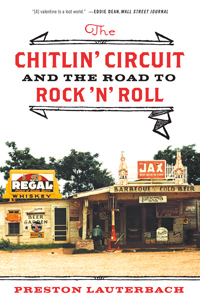There’s no single bullet theory of rock ‘n’ roll to be found in The Chitlin’ Circuit; no one place or lone artist is credited. While there’s no question that American rock ‘n’ roll culture hit phenomenon status via white artists like Bill Haley and Elvis Presley, rock ‘n’ roll music developed through changes in black America’s entertainment business and musical trends, beginning in World War II.
It all began in summer 1942 with a tough Texas promoter and a revolutionary artist named Louis Jordan. Until then, big bands dominated black pop and circuit business. Louis Jordan and his Tympany Five, however, brought a new approach to the field. They blared small band swing and Jordan sang clever, quicksilver lyrics, emphasizing downhome imagery, rather than the sort of suave Ellingtonian mystique that had been the prevailing vibe through swing music. Jordan’s use of a five-piece and putting the vocals up front started a new fad that caught on with audiences and aspiring musicians alike.
The Chitlin’ Circuit goes inside the Bronze Peacock nightclub in Houston at the thrilling time of rock’s first steps. Run by the powerful Houston kingpin Don Robey—the promoter who’d helped launch Louis Jordan back in ’42—the Peacock became a hub for rockin’ circuit business people, and a laboratory for the new sound. It’s after-hours jam sessions mixed new The club broke new artists like Amos Milburn and “Gatemouth” Brown, and was the site of one of the more monumental meetings in rock ‘n’ roll history in spring 1947, when New Orleans bandleader Dave Bartholomew met Los Angeles record man Lew Chudd. They went on to bring Crescent City pianist named Fats Domino to the world via Bartholomew’s artistic direction and Chudd’s Imperial Records imprint.
By 1948 singer Roy Brown was wailing numbers like “Good Rocking Tonight” and “Boogie at Midnight” on perhaps the most sensational coast-to-coast ride chitlin’ circuit audiences had seen. He and his band the Mighty Mighty Men set new standards for showmanship, sweating through five suits per show, as saxophonist Leroy “Batman” Rankins leapt from the rafters and danced across tables. Rock ‘n’ roll was more than a new sound, Roy Brown elevated it to hysteria. They rocked black America from Beale Street to the Apollo, down the Atlantic coast, through the Deep South to the Arizona desert, selling out every night for nearly a year. When Roy “Good Rockin’” Brown broke for Christmas in 1949, Bill Haley was yodeling in chaps, and Elvis Presley was still five years shy of “inventing” rock ‘n’ roll in a Memphis recording studio.



